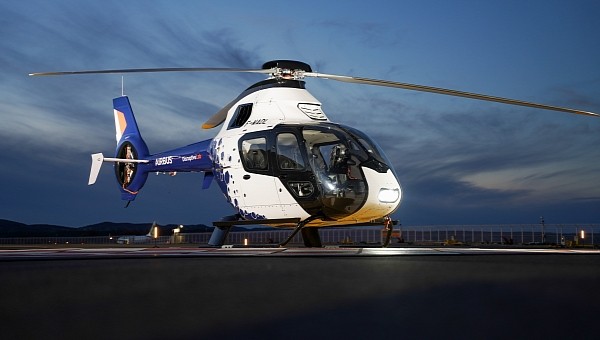Airbus is proving to be relentless in its pursuit of eco-friendly innovations – in the air, at sea, onboard airplanes, helicopters, and ships. Like other major players in the industry, it doesn’t limit its research to one potential avenue, but tests everything from hydrogen technology to SAF (sustainable aviation fuel) and hybrid propulsion systems.
In the summer of 2022, Airbus was linked to eco-friendly milestones in the world of rotorcraft. First, it successfully conducted the first SAF-powered helicopter flight in Japan, together with the Japanese operator Nakanihon Air (NNK). Soon after, it used 100% SAF to feed both of the Makila 2 engines that propel the Airbus H225. It was the first time that an Airbus chopper would rely entirely on green jet fuel, and the pioneering test flight was a success.
On the other hand, Airbus was also working on a different approach to lowering CO2 emissions. This one focused on a new rotorcraft design that would increase performance and burn less fuel. Plus, it would be adapted for a hybrid propulsion system that enables in-flight battery recharging.
The demonstrator for this innovative technology was named DisruptiveLab, because it’s meant to act as a flying laboratory for the new design and propulsion system.
The design highlights include an aluminum and composite fuselage, a more compact rotor head thanks to a new way of integrating the blades, and a lighter rear fuselage (with a Fenestron tail rotor). All of this is supposed to reduce drag, for improved energy efficiency. By burning less fuel, the new helicopter would be able to cut CO2 emissions by up to 50%.
The DisruptiveLab was unveiled last year, at the end of November, and it recently took to the sky for the first time, marking the beginning of upcoming tests. It should not be confused with FlightLab, another Airbus demonstrator that was launched back in 2020. That one was meant for tests related to rotorcraft autonomy and safety, while this new one is specifically designed for reducing the environmental footprint and lowering noise levels.
The potential outcome of this upcoming research is what the aviation giant calls “disruptive design” – all-new futuristic aircraft that look very different than what we’re used to, and that boast much better performance and fuel efficiency.
When it comes to helicopters, “Racer” is the name of a high-speed concept that would be able to cruise at 400 kph (248.5 mph) while also claiming to be up to 15% more efficient than current rotorcraft. Featuring a lightweight metallic-composite airframe, and powered by the Safran Eco-Mode hybrid-electric system, the Racer could deliver outstanding performance and efficiency for commercial operations.
In the meantime, the new DisruptiveLab is ready to show what it can do, and it’s being partly financed by European funds, through the French Civil Aviation Authority (DGAC).
On the other hand, Airbus was also working on a different approach to lowering CO2 emissions. This one focused on a new rotorcraft design that would increase performance and burn less fuel. Plus, it would be adapted for a hybrid propulsion system that enables in-flight battery recharging.
The demonstrator for this innovative technology was named DisruptiveLab, because it’s meant to act as a flying laboratory for the new design and propulsion system.
The design highlights include an aluminum and composite fuselage, a more compact rotor head thanks to a new way of integrating the blades, and a lighter rear fuselage (with a Fenestron tail rotor). All of this is supposed to reduce drag, for improved energy efficiency. By burning less fuel, the new helicopter would be able to cut CO2 emissions by up to 50%.
The DisruptiveLab was unveiled last year, at the end of November, and it recently took to the sky for the first time, marking the beginning of upcoming tests. It should not be confused with FlightLab, another Airbus demonstrator that was launched back in 2020. That one was meant for tests related to rotorcraft autonomy and safety, while this new one is specifically designed for reducing the environmental footprint and lowering noise levels.
The potential outcome of this upcoming research is what the aviation giant calls “disruptive design” – all-new futuristic aircraft that look very different than what we’re used to, and that boast much better performance and fuel efficiency.
When it comes to helicopters, “Racer” is the name of a high-speed concept that would be able to cruise at 400 kph (248.5 mph) while also claiming to be up to 15% more efficient than current rotorcraft. Featuring a lightweight metallic-composite airframe, and powered by the Safran Eco-Mode hybrid-electric system, the Racer could deliver outstanding performance and efficiency for commercial operations.
In the meantime, the new DisruptiveLab is ready to show what it can do, and it’s being partly financed by European funds, through the French Civil Aviation Authority (DGAC).
The 1st flight of #DisruptiveLab is a dream come true for the pioneers tackling the carbon footprint of ????. A 50% reduction in CO2 emissions thanks to a new vehicle architecture that optimises drag & a purpose-built hybrid propulsion system that recharges the battery in flight. pic.twitter.com/WxUNkoarbM
— Airbus Helicopters (@AirbusHeli) January 13, 2023







